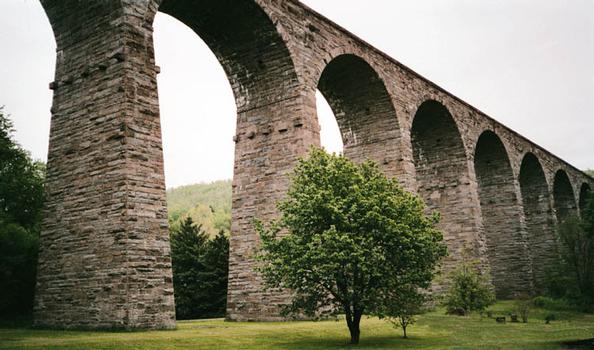General Information
Project Type
| Structure: |
Semi-circular arch bridge |
|---|---|
| Function / usage: |
Railroad (railway) bridge |
| Material: |
Masonry bridge Structurae Plus/Pro - Subscribe Now! |
Awards and Distinctions
| 1973 |
for registered users |
|---|
Location
| Location: |
Lanesboro, Susquehanna County, Pennsylvania, USA |
|---|---|
| Crosses: |
|
| Coordinates: | 41° 57' 49.85" N 75° 35' 0.19" W |
Technical Information
Dimensions
| height | 33.5 m | |
| total length | 317.2 m | |
| span lengths | 17 x 15.25 m | |
| number of spans | 17 | |
| number of tracks | 2 |
Cost
| cost of construction | ca. United States dollar 300 000 |
Materials
| piers |
masonry
|
|---|---|
| arches |
masonry
|
Chronology
| 9 December 1848 | First locomotive crosses the bridge |
|---|
Notes
Excerpt from Wikipedia
Starrucca Viaduct is a stone arch bridge that spans Starrucca Creek near Lanesboro, Pennsylvania, in the United States. Built at a cost of $320,000 (equal to $9,266,462 today), it was at the time of its construction thought to be the most expensive railway bridge in the world. It was the largest stone rail viaduct in the mid-19th century and is still in use.
Construction
The viaduct was designed by Julius W. Adams and James P. Kirkwood and built in 1847-48 by New York and Erie Railroad, of locally quarried random ashlar bluestone, except for three brick interior longitudinal spandrel walls and the concrete base of the piers. This may have been the first structural use of concrete in American bridge construction.
It was built to solve an engineering problem posed by the wide valley of Starrucca Creek. The railroad considered building an embankment, but abandoned the idea because it was impractical. The Erie Railroad was well-financed by British investors, but even with money available, most American contractors at the time were incapable of the task. Julius W. Adams, the superintending engineer of construction in the area, hired James P. Kirkwood, a civil engineer who had worked on the Long Island Rail Road. Accounts differ as to whether Kirkwood worked on the bridge himself, or whether Adams was responsible for the plans with Kirkwood working as a subordinate. The lead stonemason, Thomas Heavey, an Irish immigrant from County Offaly, had worked on other projects for Kirkwood, primarily in New England. It took 800 workers, each paid about $1 per day, equal to $28.96 today, to complete the bridge in a year. The falsework for the bridge required more than half a million feet of cored and hewn timbers.
The original single broad gauge track was replaced by two standard gauge tracks in 1886. The roadbed deck under the tracks was reinforced with a layer of concrete in 1958.
The bridge has been in continual use for more than a century and a half, and is still in use by the Norfolk Southern Railway. In 2005 Norfolk Southern leased the portion of the line from Port Jervis, New York to Binghamton, New York to the Delaware Otsego Corporation, which operates it under the name Central New York Railway. The only railroad currently using it is DO's New York, Susquehanna and Western Railway.
The viaduct is listed on the National Register of Historic Places and is a Historic Civil Engineering Landmark.
Text imported from Wikipedia article "Starrucca Viaduct" and modified on July 22, 2019 according to the CC-BY-SA 4.0 International license.
Participants
Relevant Web Sites
Relevant Publications
- (1997): Bridges. A history of the world's most famous and important spans. Black Dog & Leventhal, New York (USA), pp. 40-41.
- (2017): Bridges. A History of the World's Most Spectacular Spans. 2nd edition, Black Dog & Leventhal, New York (USA), ISBN 978-0316507943, pp. 40-41.
- (1998): Brücken. Die Geschichte berühmter Brücken. Könemann, Cologne (Germany), pp. 40-41.
- (1984): Great American Bridges and Dams. A National Trust Guide. John Wiley & Sons, New York (USA), pp. 146-147.
- : Les ponts. Une histoire des plus grands et plus célèbres ponts du monde. Könemann, Cologne (Germany), pp. 40-41.
- About this
data sheet - Structure-ID
20001298 - Published on:
10/02/2001 - Last updated on:
24/06/2022





